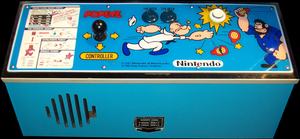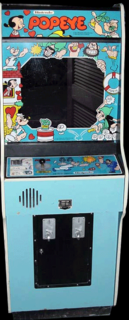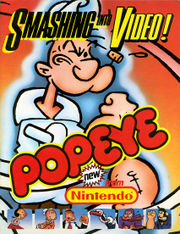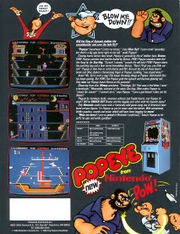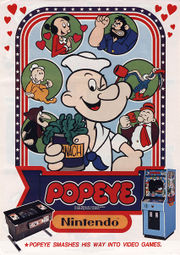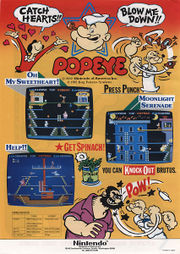Lost In Translation/Popeye (arcade)
| Popeye | |
|---|---|
| Manufacturer | Nintendo |
| Released | 1982 |
| Control Method |
4-way Joystick 1 Button(s) |
| Main CPU | Z80 (@ 4.000 MHz) |
| Sound CPU | Mono AY-3-8910A (@ 2.000 MHz) |
| Video Details |
Raster (Horizontal) 512 x 448 pixels 60.00 Hz 288 Palette colours |
| Screens | 1 |
| ROM Info | 14 ROMs 70,464 bytes (68.81 KiB) |
| MAME ID | popeye · popeyebl · popeyef · popeyeu |
About The Game
Popeye is a platform-based arcade video game featuring characters from the famous King Features Syndicate cartoon show of the same name. The aim of the game is to rescue Popeye's girlfriend, Olive Oyl. This is achieved by catching a set number of objects thrown down by Olive from the top of the screen; such as hearts, letters and musical notes. Popeye is constantly pursued in his quest by love rival, Bluto (a.k.a. Brutus). Popeye must either run away from Bluto or grab some spinach and punch him off the screen (he will, of course, return).
Should any of Olive Oyl's items fail to be caught, they will fall into the water at the bottom of the screen. Popeye will then have only a few seconds to retrieve the object or a life is lost. Several other Popeye characters also make an appearance in the game; namely Wimpy, Sweet-pea, the Sea Hag and her Vulture, whose name is Bernard. The game's three levels are the dock scene, the street scene and the shipboard scene. These repeat with increasing difficulty.
Trivia
Released in December 1982.
Licensed to Atari for some distributions.
Popeye From Strip To Screen
Popeye the Sailor, one of the most enduring characters in animation history, began not in motion pictures but in E.C. 'Elzie' Segar's 'Thimble Theater' comic strip. Born in Illinois, Segar began cartooning in Chicago in 1914. Graduating to his own strip for the Chicago American, Segar was then hired in 1919 by Hearst's New York Evening Journal to create the syndicated 'Thimble Theater' strip. 'Thimble Theater' depicted the adventures of Ham Gravy, his girlfriend Olive Oyl and her brother Castor. The venture was a success, expanding to an additional Sunday colour page in 1924. Segar's comic strip used complex, rambling and frequently eerie narratives that attracted a devoted following, but it lacked strong central characters. In the 'Thimble Theater' of January 17, 1929, Ham and Castor decided to hire a crew to sail in search of the legendary Whiffle Hen. Walking up to a grizzled one-eyed mariner on a dock, Castor asked him, "Are you a sailor?" "`Ja think I'm a cowboy?" came the reply, introducing Popeye to readers.
Move Over, Ham Gravy
Over a period of months, Popeye developed from a supporting character to the central figure in the hunt for the Whiffle Hen. When Segar finally brought the narrative to a close and tried to retire the sailor, outraged fans contacted the Hearst syndicate demanding more adventures with Popeye. Segar obliged them : the sailor replaced Ham as Olive's love interest, Castor Oyl was reduced to infrequent appearances, and the strip was renamed 'Thimble Theater, Starring Popeye'.
The early 1930s was a period of keen competition among American animation studios for market share. Central to the business strategy of most studios was the development of cartoon 'stars' whose popularity would ensure bookings by major theater chains. Disney followed the success of Mickey Mouse by developing new characters like Donald Duck and Goofy up from supporting roles in Mickey Mouse cartoons. Similar strategies were tried at Warner Bros., where Bugs Bunny and Daffy Duck evolved from secondary roles in films starring other animated characters. One of the earliest examples of this took place at the Fleischer Studios, Inc. in New York, where the unpopular starring canine character Bimbo was matched up with a girlfriend in Dizzy Dishes (1930). The girlfriend eventually developed into Betty Boop, the studio's major character. With the popularity of Betty Boop at a peak in 1932, brothers Max and Dave Fleischer decided to introduce a new film series which would include another character to grow into a star. Fleischer rival Van Beuren Corporation had already signed an agreement to bring Otto Soglow's strip 'The Little King' to the screen. Max Fleischer, who was a great fan of Segar's strip, approached Hearst's King Features Syndicate for the right to use Popeye. The two companies signed an agreement on November 17, 1932.
Betty Introduces Popeye to the Big Screen
The production of the first Popeye film took place in secrecy. Veteran animator Roland Crandall was given space apart from the rest of the studio. There, he single-handedly animated the entire cartoon, aided only by the inclusion of some Shamus Culhane animation recycled from the earlier Betty Boop's Bamboo Isle (1932). The results were so satisfying that even before the film was released, the Fleischers and King Features amended the agreement granting the studio the right to produce and release animated cartoons featuring Popeye for a five year period.
Crandall's film 'Betty Boop Presents Popeye The Sailor' opened in the summer of 1933 as part of the 'Betty Boop' series. After a prologue in which newspapers herald the sailor's film debut, and Popeye sings 'I'm Popeye the Sailor Man', the film featured what was to be the standard 'Popeye' series plot, re-enacted with variations by the Fleischers for the next decade. Olive waits for Popeye to disembark from his ship at the dock. Bluto follows the couple to a fairground, where the two sailors compete for Olive's attentions through feats of strength. Bluto abducts Olive and ties her to a train track. As the locomotive approaches, Popeye and Bluto fight. Popeye defeats Bluto, and, through the magical powers of spinach, is able to stop the train and save Olive Oyl. Here, we see the essential difference between the Segar and Fleischer sense of narrative. Segar reveled in picaresque plots that coursed in unexpected directions for up to two years, exploring every novel twist and nuance of narrative. In anticipation of post-modernism, the very concept of plot was old-fashioned to the Fleischers. Hackneyed and ritualized story conventions were torn apart, recombined in odd juxtapositions, and satirized in endless variations.
The Fleischer Popeye cartoons were an instant success. "It might have been just a fluke, a lucky break, that the Segar characters fit the Fleischer style so well", recalls former Popeye animator Myron Waldman. "The animation of Olive Oyl in the mid-1930s was perfect. It fit her. The character had no elbows and the most prominent knees. When she spoke, the voice fit too. This was character. That's what made her so good".
Step Aside, Mickey
Segar's characters were not the only things consistent with the Fleischer style. Both Segar and the Fleischer staff shared a fondness for a poetically improvisational language. When Popeye's original voice artist, William 'Red Pepper Sam' Costello, left after the first few pictures, he was replaced by a studio in-betweener named Jack Mercer. Much of the dialogues of the Popeye cartoons was post-synched with little attention to synchronized mouth action. Mercer, Mae Questel (Olive's voice, except for the 1938-41 period, when Margie Hines was the voice artist) and William Penell or Gus Wickie, who voiced Bluto, often ad-libbed dialogues during recording sessions, particularly Popeye's 'asides' and pun-filled conversations. Added to this was a progressive softening and increased complexity of Popeye's character, paralleling changes in the strip. Popeye cartoons became the Fleischers' leading attraction. By 1938, Popeye replaced Mickey Mouse as the most popular cartoon character in America.
The Fleischers rummaged through the Segar strip for supporting characters. Bluto, the animated series' antagonist, was a minor character in the Segar strip, appearing only in 1933's 'The Eighth Sea'. Longer-lived strip characters that joined Popeye on the screen included hamburger maven J. Wellington Wimpy, Swee'pea, Eugene the Jeep and Poopdeck Pappy. While in the comic strip, Popeye gained his great strength from rubbing the Whiffle Hen, the Fleischers added the gimmick of Popeye's power being largely dependent on the ingestion of spinach. Farmers in America's self-styled 'spinach capital' of Crystal City, Texas set up a statue of Popeye in gratitude for the publicity.
As early as 1935, the Fleischers sought backing for a feature-length animated film from their distributor Paramount. Paramount refused to risk money on a feature. In an attempt to persuade the company that longer animated films could be profitable, Max Fleischer initiated the production of three two-reel color 'specials' starring Popeye, beginning with 'Popeye The Sailor Meets Sinbad The Sailor' (1936). Although these 'specials' were often billed over their accompanying feature, Paramount still refused to back the animated feature.
Conditions changed after the success of Disney's 'Snow White And The Seven Dwarfs' (1937) and the Fleischers received money for the eighty minute Gulliver's Travels. According to some sources, the film was originally to have Popeye in the role of Gulliver, but the idea was scrapped early in the planning stages. Perhaps this was unwise. According to internal Paramount correspondence, the Popeye shorts were far more profitable to Paramount than Disney's films were to his distributor, RKO. The sailor's box-office appeal might have helped the Fleischer features. Gulliver's Travels (1938) and the company's next feature, Mr. Bug Goes To Town (1941), bombed, leading to the failure of Fleischer Studios, Inc.
Post-Fleischer Popeye
The successor company, Famous Studios, continued with the production of Popeye cartoons. Many of these were remakes of earlier Fleischer films. Much of the supporting cast of the Fleischer versions were replaced by new characters, such as identical nephews Pip-Eye, Peep-Eye, Poop-Eye and Pup-Eye. A redesign of the major characters included white U.S. Navy uniforms for Bluto and Popeye (in keeping with their war-time service in the armed forces), and more comely fashions for Olive. Upgraded technology, including the introduction of color to the series in 1943 with Her Honor The Mare and 3-D in Popeye The Ace Of Space (1953), tried to rejuvenate the series. None of these strategies were able to breathe much life into the films. Spooky Swabs (1957) brought theatrical release of Popeye films to a close.
The success of the black and white Popeye cartoons on television in the 1950s inspired several revivals of the series by such talents as Gene Deitch, John Halas and Joy Batchelor, Jack Kinney, and Hanna-Barbera. Hampered by limited budgets and rushed production schedules, none of these came close to the Fleischer or Famous theatrical versions. The less said about Robert Altman's live-action feature with Robin Williams and Shelley Duvall as Popeye and Olive Oyl, the better. What has endured are the original qualities of the Segar and Fleischer works. In fact, Segar's strips have been reissued by Nostalgia Press and the Smithsonian Press. The earlier Fleischer films, which shared the shabby urban or surreal exotic locations and working-class orientation of the Segar originals, retain a vitality and charm that still appeal to a large group of devoted fans today.
Steve Harris holds the official record for this game with 1,232,250 points.
Parker Brothers released a board-game based on this video-game (same name) in 1983 : The board is laid out like the first level of the video-game.
Updates
- REVISION F (designed especially for novice players)
- First level has a colored background (instead of black).
- Default high-score smaller : 25600 (instead of 32600).
- First nickname on the default high-score table changed to KAC (instead of GET).
- Spinach is restored after you lose a life.
- The ladder at the center of the first level can be used to go up or down.
- Extra Life dip-switch can be set at 20000, 30000, 50000, or None. The default is 20000, meaning you get an extra life at 20000 points.
- BOOTLEG
- No copyright
Scoring
Collecting a heart, note, or letter on the...
| Floor | Points |
|---|---|
| 1st floor | 50 (1) |
| 2nd floor | 100 (1) |
| 3rd floor | 300 (1) |
| 4th floor | 500 (1) |
| Target | Points |
|---|---|
| Punching the punch-bag | 30 |
| Punching a bottle | 100 |
| Punching a skull | 100 |
| Punching Bernard | 1,000 |
| Using Spinach power to knock Bluto into the water | 3,000 |
Dropping the bucket on Bluto's head when he's on the...
| Floor | Points |
|---|---|
| 1st floor | 4,000 |
| 2nd floor | 2,000 |
| 3rd floor | 1,000 |
Hitting Sweet-pea's platform from below : 500 points(1).
NOTE : The Punch button is not required to punch Bluto or Bernard when Popeye has Spinach power.
(1) denotes values that are doubled if Popeye has Spinach power.
Tips and tricks
A Display Glitch
On the musical note level, you can stand at the point on the edge where you 'wraparound' and if you punch a bottle in the right spot, it'll erase part of the 'THRU' sign. This can be done on both sides.
Level One
- On the first level, Olive Oyl stands at the top of the screen and throws 24 hearts (one at a time) down to the bottom, hoping that Popeye will catch them all. If a heart reaches the bottom of the screen, you will have about 10 seconds to pick it up before it breaks, costing you one life. Try to catch the hearts as high as possible, since they decrease in value as they get closer to the bottom.
- When Bluto harasses you, cross the edge of the screen from left to right and wait for him to stop directly underneath the bucket. Hit the punching bag at this point and the bucket will fall onto his head, rendering him helpless for a while. This will score you points based on which floor Bluto is on when you hit him (see Scoring above) and give you some time to catch a few more hearts.
- Like in the cartoons, Popeye becomes stronger after eating Spinach. A can of Spinach moves between the second and third floors of the screen and you can have Popeye eat it by punching the can. Afterwards, Popeye will turn red and become stronger than Bluto for about 10 seconds (shorter in later levels). If you can punch Bluto at this time, he falls into the sea, temporarily knocked out, and you will be awarded 3,000 points.
- Bluto will eventually recover so make good use of this time by catching as many falling hearts as possible. They don't move, and they are worth twice as much when Popeye is under the influence of Spinach, so catching some of the higher hearts can really help your score. And since extra lives are only awarded at a very high score (60,000 points on most machines; 20,000 points by default on Revision F machines), you should be as greedy as possible.
- Spinach can only be used once per level, and it is never restored after you lose a life (except in Revision F, see Updates above). Do not use it too soon; collect about two thirds of the total number of hearts, and have as many hearts fill the air as possible before getting the Spinach.
- If you want to risk getting 4,000 points instead of 2,000, do not use the punching bag immediately. Wait until you have punched Bluto (best done when after eating Spinach) and next position Popeye to the punching bag. After Bluto comes out of the sea, he will move underneath the bucket on the bottom floor. With some practice and timing you should be able to drop the bucket onto his head for 4000 points. NOTE : touching Bluto while the bucket is on his head is not fatal. But be careful, because after the bucket comes off he can easily knock out Popeye.
- To make up for his lumbering slowness, Bluto is capable of throwing beer bottles at Popeye. You should try to force him to throw bottles as often as possible (four at a time) instead of avoiding them, so you can score extra points.
- The Sea Hag also throws bottles, except she only throws one at a time. The Sea Hag materializes on the edge of the screen for a moment, chucks a bottle, and disappears. She can also be on both sides of the screen at once. So if you are caught between two Sea Hags or between Bluto and The Sea Hag, you will have to quick on the joystick and Punch button to survive.
Level Two
- The second level is much like the first, except Olive Oyl is dropping musical notes now (16 of them, one at a time), the major difference is the layout, with Wimpy on the plank in the lower corner. If Popeye jumps off the second floor, he will be catapulted up to the third floor. With some careful timing, you can even make Popeye leap all the way up to the fourth floor, where Sweet-pea is waiting on a balloon platform. Touching the bottom of Sweet-pea will score 500 points (1000 points while under the influence of Spinach).
Level Three
- The setting for the third level is a ship, with a sliding platform on the top floor. At the beginning of the board you should be able to slide Popeye across the platform several times, catching the letters H-E-L-P that Olive Oyl is dropping directly above.
- Every time Popeye catches a letter, one step is added to a ladder which goes up to Olive Oyl When the ladder is finished, Olive Oyl is rescued. This is the most difficult level, because a total of 24 letters are needed to complete the ladder and save Olive Oyl. Bernard, the vulture, will constantly appear from the left side of the screen. While sliding back and forth across the platform, you should try to punch Bernard as many times as possible, to score 1,000 points per punch.
- After Popeye has rescued Olive Oyl on the third level, there will be an intermission that will have Popeye's face while "I'm Popeye The Sailor Man" plays followed by Popeye blowing his pipe and going "Toot! Toot!". Afterwards, the game begins again with increased difficulty.
On ALL levels, Bluto can reach from underneath or bend down from higher floors to lower ones- be careful that you are not underneath him.
When the game restarts from the first level with increased difficulty, The Sea Hag will throwing down deadly bouncing skulls from the edges of the screen and must be punched when they are bouncing upward. You must also make sure that there are no skulls directly above Popeye, since they drop down a floor or two and hit him on the head.
Continue to avoid Bluto, Bernard, the beer bottles, and the skulls, and keep catching whatever Olive Oyl throws down.
Cabinet and Artwork
Ports
- Consoles
- Atari XEGS
- G7000 Videopac
- Colecovision (1983)
- Atari 2600 (1983)
- Mattel Intellivision (1983)
- Atari 5200 (1984)
- Nintendo Famicom (1986)
- Computers
- Atari 800 (1983)
- Commodore C64 (1984)
- Texas Instruments TI-99/4A (1984)
External Links
- Sinclair ZX Spectrum version of Popeye at the World of Spectrum




